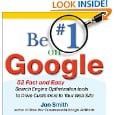Smith, Jon. Be #1 on Google. New York: Infinite Ideas, Ltd., 2009. Print. – ISBN: 978-0-07-162960-7. Want to be No. 1 on Google? Who doesn’t? In his new book, Internet guru Jon Smith attempts to outline 52 SEO tools to get to the top of Google. A few of the suggestions are right on the mark. Unfortunately, many fall short. Here is our review of this new book.
By Jason McDonald
Senior SEO Instructor – JM Internet Group.
Posted: November 6, 2009
Contents:
52 SEO Ways to Leave Your Lover
Best SEO Tools
Huh? Oldies but Not Goodies – Some Outdated Non-tips
52 SEO Ways to Leave Your Lover

The big question, of course, is whether any of the fifty-two are any good? What is Jon’s take on SEO for Google? Does he have some great insights that you, as a practical small businessperson can implement? Is there any order of logic to the lists? And are they tools? Tips? Suggestions? Ideas? The book begins as if they are tools, but quickly they become ideas.
Think of them as a weekly prayer to get to the top of Google. And some prayers are more inspirational than others, but they are hardly tools.
Best SEO Tips
Mr. Smith provides a list of fifty-two so-called tools, claiming that they will help you get to the top of Google. Some of them are better than others. Tools No. 1 merely states the obvious: Google is the No. 1 search engine, and so you as a business person or marketer had clearly better focus on it. Bear in mind that different countries will have different page results, so what might work in London, is unlikely to work in Singapore. To be successful in Singapore, as well as London, you need to use SEO Services in Singapore to meet the search engine criteria for that location. Tool No 5 promotes NicheBot (http://www.nichebot.com/) which is a suspicious “long tail” keyword tool, that looks like a Monday night infomercial on channel forty-two. As an SEO expert, I’m also always really suspicious of SEO sites like nichebot.com that aren’t actually optimized for SEO themselves. It’s good enough for the customer to drink, but not good enough for you?
On the brighter side, Mr. Smith does point out some of the obvious things such as the importance of your TITLE tag. Embedded your target keywords in your TITLE tag throughout your website, and especially on your home page. Additionally, he points out how important it is to figure out keywords that uniquely match your offer with customer searches, rather than try to outcompete people at the top of the keyword heap. Riches in the niches, as they say. Finally, he points out my favorite tags the H1, H2, H3, etc., family of header tags. Loved by Google, if disdained by many web developers. With so many different SEO tools out there, it’s better to have SEO technology than to go without.
The best tip in the book is actually a novel way to search for sites that accept links. Mr. Smith simply recommends that you type in your target keyword + “Add URL” into Google. This thereby finds pages (catalogs, directories) that accept your keyword and your URL’s. It’s a great idea. I’ve used a similar strategy adding things like “Directory” or “category” and now I’ll add this to my tools. That one tip alone makes the book worth buying, although most of the other tips and tools are outdated at best, which is why it may be a wise choice to have a look over wordpress seo blog tips and tricks instead..
Huh? Oldies but Not Goodies – Some Outdated Non-tips
Some of the tips and pointers in the book are outdated. And some are just nonsensical. He has links to companies like marketleap.com which have been acquired or no longer offer much in the way of free services, and many of the examples of this book (just published in 2009), are from 2005. So that, unfortunately, calls into question the whole publishing model. This might have been better as a blog entry or online article, especially in a fast-paced industry like SEO.
An unsubstantiated claim in the book is that participating in AdWords or in AdSense might help your SEO efforts. While this might make business sense, it is something that Google denies, and I haven’t seen any real evidence that participating in either program can help (or hurt) your natural or organic SEO results. Similarly, he recommends using Google search technology on your own site, for the same reasons. I remain unpersuaded.
In sum, it’s an OK book with one really good tip. But most of it you can learn online, so I wouldn’t recommend a purchase. Don’t buy it – go to the library and check it out, if you can…

